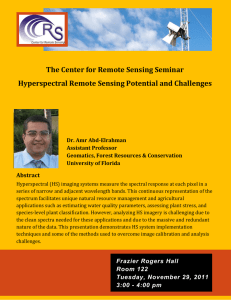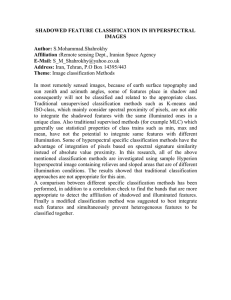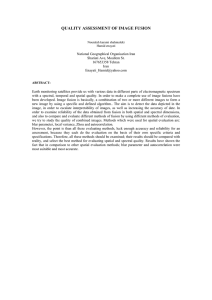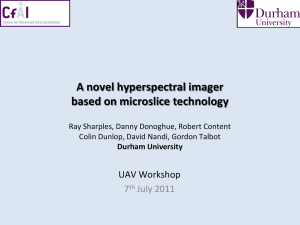SUPER-RESOLUTION: AN EFFICIENT METHOD TO - GIPSA-lab
advertisement
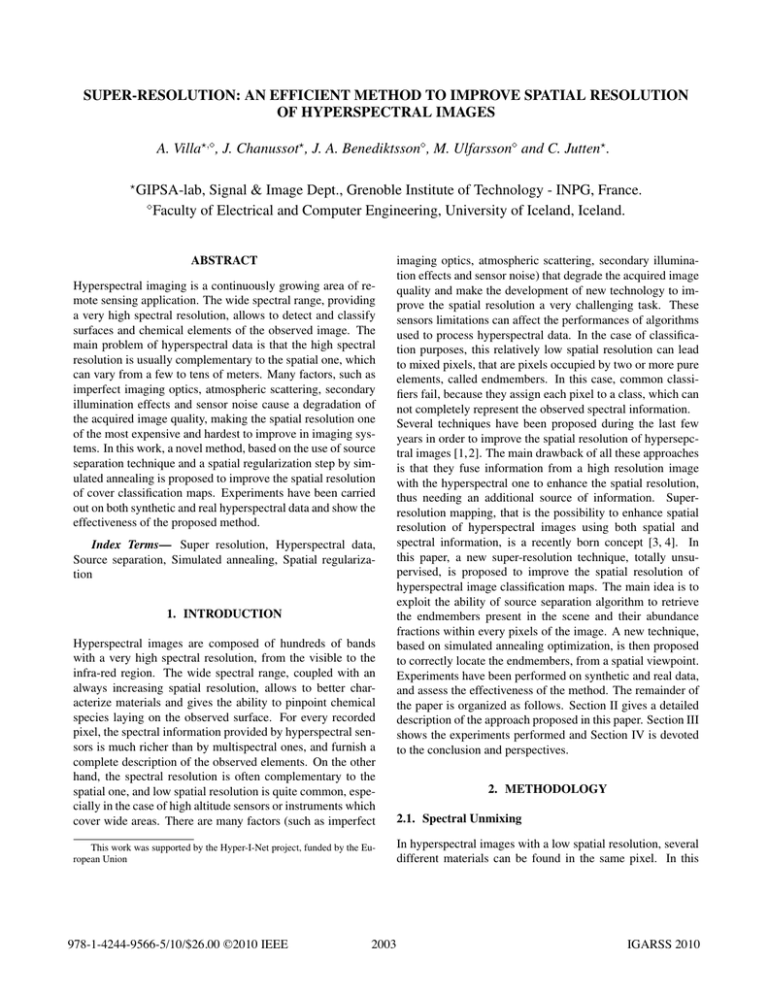
SUPER-RESOLUTION: AN EFFICIENT METHOD TO IMPROVE SPATIAL RESOLUTION OF HYPERSPECTRAL IMAGES A. Villa, , J. Chanussot , J. A. Benediktsson , M. Ulfarsson and C. Jutten . GIPSA-lab, Signal & Image Dept., Grenoble Institute of Technology - INPG, France. Faculty of Electrical and Computer Engineering, University of Iceland, Iceland. ABSTRACT Hyperspectral imaging is a continuously growing area of remote sensing application. The wide spectral range, providing a very high spectral resolution, allows to detect and classify surfaces and chemical elements of the observed image. The main problem of hyperspectral data is that the high spectral resolution is usually complementary to the spatial one, which can vary from a few to tens of meters. Many factors, such as imperfect imaging optics, atmospheric scattering, secondary illumination effects and sensor noise cause a degradation of the acquired image quality, making the spatial resolution one of the most expensive and hardest to improve in imaging systems. In this work, a novel method, based on the use of source separation technique and a spatial regularization step by simulated annealing is proposed to improve the spatial resolution of cover classification maps. Experiments have been carried out on both synthetic and real hyperspectral data and show the effectiveness of the proposed method. Index Terms— Super resolution, Hyperspectral data, Source separation, Simulated annealing, Spatial regularization 1. INTRODUCTION Hyperspectral images are composed of hundreds of bands with a very high spectral resolution, from the visible to the infra-red region. The wide spectral range, coupled with an always increasing spatial resolution, allows to better characterize materials and gives the ability to pinpoint chemical species laying on the observed surface. For every recorded pixel, the spectral information provided by hyperspectral sensors is much richer than by multispectral ones, and furnish a complete description of the observed elements. On the other hand, the spectral resolution is often complementary to the spatial one, and low spatial resolution is quite common, especially in the case of high altitude sensors or instruments which cover wide areas. There are many factors (such as imperfect This work was supported by the Hyper-I-Net project, funded by the European Union 978-1-4244-9566-5/10/$26.00 ©2010 IEEE 2003 imaging optics, atmospheric scattering, secondary illumination effects and sensor noise) that degrade the acquired image quality and make the development of new technology to improve the spatial resolution a very challenging task. These sensors limitations can affect the performances of algorithms used to process hyperspectral data. In the case of classification purposes, this relatively low spatial resolution can lead to mixed pixels, that are pixels occupied by two or more pure elements, called endmembers. In this case, common classifiers fail, because they assign each pixel to a class, which can not completely represent the observed spectral information. Several techniques have been proposed during the last few years in order to improve the spatial resolution of hypersepctral images [1, 2]. The main drawback of all these approaches is that they fuse information from a high resolution image with the hyperspectral one to enhance the spatial resolution, thus needing an additional source of information. Superresolution mapping, that is the possibility to enhance spatial resolution of hyperspectral images using both spatial and spectral information, is a recently born concept [3, 4]. In this paper, a new super-resolution technique, totally unsupervised, is proposed to improve the spatial resolution of hyperspectral image classification maps. The main idea is to exploit the ability of source separation algorithm to retrieve the endmembers present in the scene and their abundance fractions within every pixels of the image. A new technique, based on simulated annealing optimization, is then proposed to correctly locate the endmembers, from a spatial viewpoint. Experiments have been performed on synthetic and real data, and assess the effectiveness of the method. The remainder of the paper is organized as follows. Section II gives a detailed description of the approach proposed in this paper. Section III shows the experiments performed and Section IV is devoted to the conclusion and perspectives. 2. METHODOLOGY 2.1. Spectral Unmixing In hyperspectral images with a low spatial resolution, several different materials can be found in the same pixel. In this IGARSS 2010 (a) Table 1. Correlation coefficient for some of the considered ele- ments (b) Brick Dry grass Lichen 0.87 0.79 0.81 Brick x 0.89 0.88 Dry grass 0.89 x 0.93 Asphalt (c) Fig. 1. Basic steps of the proposed method: (a) Spectral unmixing provides information about abundance fraction within each pixel (b) Pixels are split into n sub-pixels, according to the desired zoom factor, assigned to an endmember and randomly positioned within the pixel (c) Simulated annealing performs random permutations of the sub-pixels position until the minimum cost is reached case, a common hard classification process, where each pixel is assigned to a class, fails. A solution consists in using source separation, in order to retrieve the mixed endmembers lying within each pixel [5]. Spectral unmixing is the first step of the proposed approach, due to its ability to provide a complete description of each pixel. In the last years, several algorithms have been developed for automatic or semi-automatic extraction of spectral endmembers directly from the image data [6]. In [7], the Vertex Component Analysis (VCA) is proposed as an effective method for extracting the endmembers which are linearly mixed. The main principle of VCA is to project the data in a properly chosen hyperplane, where all the image pixels are contained in a simplex whose vertices correspond to the endmembers. This algorithm has been chosen in our work due to its good performances with respect to several source separation algorithms both for the accuracy of retrieved endmembers and from a computational point of view. Once the endmembers are extracted from the image, the abundance fraction of the elements within each pixel should be determined. Several algorithms have been developed to handle the linear mixing model according to the required constraint of abundances fractions, which are nonnegativity and full additivity. Due to the efficiency from a computational point of view, we have chosen a fully constrained least squares (FCLS) algorithm, which satisfies both abundance constraints and is optimal in terms of least squares error [8]. 2.2. Improving Spatial Resolution Spectral unmixing is useful to describe the scene at a subpixel level, but can only provide information about proportions of the endmembers within each pixel. Since the spatial location remains unknown, spectral unmixing does not perform any resolution enhancement. In this paper, we propose a super-resolution mapping technique, which takes advantage of the information given by the spectral mixing analysis and uses it to enhance the spatial resolution of thematic maps. Our proposed approach is as follows: In a first step, each pixel is divided in a fixed number of sub-pixel, according to the desired resolution enhancement. Every sub-pixel is assigned to an endmember, in conformity with its fractional abundance 2004 within the pixel. A Simulated Annealing (SA) mapping function is then used, to create random permutation of these subpixels, in order to minimize a chosen cost function. Relying on the spatial correlation tendency of landcovers, we assume that each endmember within a pixel should be spatially close to the same endmembers in the surrounding pixels. Therefore, the cost function to be minimized is chosen as the perimeter of the areas belonging to the same endmember. Simulated annealing is a well established stochastic technique originally developed to model the natural process of crystalization [9]. This process is based on an analogy from thermodynamics where a system is slowly cooled in order to reach its lowest energy state. More recently, SA has been proposed to solve global optimization problems [10], and it has been used in various fields. The basic idea of the method is that, in order to avoid to be trapped in local minima, uphill movements, i.e., the points corresponding to worse objective function values could, sometimes, be accepted for the following iteration. As with a greedy search, it accepts all the changes that improve the solution. Changes degrading the solution can be accepted, but with a probability that is inversely proportional to the size of the degradation (small degradations are accepted with a higher probability). This probability also decreases as the search continues, or as the system cools, allowing eventual convergence to the optimal solution. 3. EXPERIMENTS 3.1. Synthetic data One of the main problems when dealing with spectral unmixing of real data is the difficulty to assess the results obtained, especially in the case of abundance fractions estimation. If the reference spectra can be easily obtained from a laboratory simulation or from in situ observations, the generation of a complete map of sub-pixel coverage is much more difficult. This is the main reason that led us to first consider synthetic data, where all the spectra and the abundance fractions are known. Here, we have chosen 9 spectra from the USGS spectral library, available on-line at [11], namely: asphalt, brick, metal sheet, roofing felt, water, dry grass, oak leaves, lichen and green slime. This library provides a very detailed spectral description of the elements, with more than 2100 considered wavelengths. To consider realistic spectra, we have down- (a) (b) (c) (d) Fig. 2. (a) Ground truth of the syntethic image created with reference spectra. (b) Ground truth after a 3x3 low pass filter. Mixed pixel are shown in black (c) Image obtained after source separation and random positioning of the elements (d) Final result after spatial regularization obtained by simulated annealing optimization 3.2. Spectral variability Table 2. Performances obtained in the different scenarios Filtering window size 3x3 4x4 SNR Inf 50 dB 30 dB 25dB Mean spectral correlation 1 1 1 0.98 Pixels unc. labeled after SS (%) 0.18 0.88 1.82 2.55 Pixels unc. positioned after SA (%) 1.95 6.47 7.37 8.97 Mixed pixels unc. positioned (%) 7.73 18.11 19.98 24.33 sampled them, so that each spectrum is composed of 216 values in the 0.3-2.5 μm range. Despite most of these spectra are not closely related, some of them have a very high spectral correlation, as it is shown in Table 1, making the source separation a challenging task. In order to create a realistic cover map, we have selected the ground truth of the AVIRIS Indian Pine image, and assigned every class to a chosen spectrum. Since the AVIRIS image contains 16 different classes, some spectra considered in our experiment can correspond to more than one class. No spectral variability is considered in this first experiment. After creating the synthetic image of 144×144 pixels which will be used later to assess the results of our method, we apply a 3×3 low pass filter, obtaining a new image composed of 48×48 pixels, with the same number of bands but a lower spatial resolution. This image is the input image of the proposed approach, to improve the spatial resolution of its classification map. The ground truths of the original and filtered images are shown in Figure 2, (a) and (b). The obtained result is shown in figure 2 (d). For a quantitative assessment of the proposed method, we perform a comparison between the original high resolution image (Figure 2a) and the image with enhanced resolution. More than 98% of the pixels were correctly located, corresponding to 92.8% of the mixed pixels. All the pure pixels were correctly labeled. 2005 In order to consider more challenging scenarios, the original image was filtered with a 4×4 low pass filter, and the influence of noise was considered. Therefore, the filtered image was composed of 1296 pixels, 818 pure and 478 mixed. Zero mean Gaussian noise was added to the original signal, with various SNRs. Three different values of SNR were tested: 50, 30 and 25 dB. The presence of noise could affect the source separation step: If the endmembers are not correctly retrieved, the optimization step will start with wrong assumptions and will inevitably lead to a bad result. As it can be seen from Table 2, the overall error increased with the noise. However, very good results were still obtained with a fair amount of noise. In the worst case, which is synthetic data with zoom factor of 4 and SNR of 25 dB, more than 91% of the image pixels were correctly labeled and positioned. 3.3. Experiments on real data In the previously discussed experiments, we have shown the effectiveness of the proposed method when considering simulated data, also in presence of noise. As long as the SNR does not become too small, the obtained results were satisfactory. When dealing with hyperspectral data, the SNR is much higher than those considered in Section 3, but other problems can affect the source separation performance, especially spectral variability of the pixel belonging to the same class. Source separation and soft classification of hyperspectral images covering wide areas is negatively related to the intra-class spectral-variability [12], and the assumption that a single endmember could extensively represent a class is generally far from reality. We consider now ROSIS data acquired over the University of Pavia, Italy, with 103 bands, ranging from 0.43 to 0.86 μm, with a 1.3 m spatial resolution. The high value of the spatial resolution is due to fact that ROSIS is an airborne sensor. Here, we consider a small segment (110×75 pixels) of the image, which contains several elements of interest, namely meadows, asphalt, metal sheet and shadows. Figures 3 (a) and (b) show a gray scale image of the 30th band of the scene and the available reference data. (a) (b) (c) (d) (e) Fig. 3. (a) Original high resolution data, band 30 (b) Ground truth of HR image (c) Low resolution image obtained after filtering (d) Classification map obtained with a k-means classifier (e) Classification map obtained with the proposed method The original image was processed with a 5×5 low pass filter, so that each pixel in the new image represents a square of 8.5 meter (Figure 3c), which is a realistic assumption when dealing with hypersepectral data. We performed two experiments on the obtained data set: Assuming that no ground truth is available to train a classifier, we first performed an unsupervised classification of the low resolution image, with a k-means classifier. In a second test, we applied the proposed method to enhance the spatial resolution of the thematic map. Results are presented in Figure 3 (d) and (e). When mixed pixels belong to the scene, as in the case here, an unsupervised classifier inevitably leads to poor results. The class shadow, represented in dark brown, which is only in a small portion of the image, was not detected, and also the metal sheet (color green) was not well retrieved. Based on a visually comparison, results obtained with the proposed method were much closer to the reference data. In order to have a quantitative assessment of the results we have compared the reference data with the obtained map. The overall accuracy was 87.46%. Curie Research Training Networks Programme under contract MRTN-CT-2006-035927, Hyperspectral Imaging Network (HYPER-I-NET). 5. REFERENCES [1] M.T. Eismann and R.C. Hardie, ”Hyperspectral resolution enhancement using high-resolution multispectral imagery with arbitrary response functions,” IEEE Trans. Geosci. Remote Sens., 43 (3) 455-465, 2005. [2] M.Q. Nguyen, P.M. Atkinson, and H.G. Lewis, ”Superresolution mapping using a Hopfield neural network with fused images,” IEEE Trans. Geosci. Remote Sens., 44 (3) 736-749, 2006 [3] A.J. Tatem, H.G. Lewis, P.M. Atkinson, and M.S. Nixon, ”Superresolution target identification from remotely sensed images using a Hopfield neural network,” IEEE Trans. Geosci. Remote Sens., 39 (4) 781-796, 2001. [4] F.A. Mianji, Y. Zhang, and A. Babakhani, ”Optimum method selection for resolution enhancement of hyperspectral imagery,” Inf. Tech. J., 8(3) 263-274, 2009. [5] N. Keshava and J. F. Mustard, ”Spectral unmixing,” IEEE Signal Proc. Mag., vol. 19, pp. 44-57, 2002. [6] A. Plaza, P. Martinez, R. Perez, and J. Plaza, ”A quantitative and comparative analysis of endmember extraction algorithms from hyperspectral data,” IEEE Trans. Geosci. Remote Sens., vol. 42, no. 3, pp. 650663, 2004. 4. CONCLUSIONS In this work a new method to enhance the spatial resolution of hyperspectral images has been proposed. The first step in this approach is source separation, in order to retrieve the endmembers of the image. Then, abundances fractions are obtained by using a fully constraint linear mixing model. Once obtained the pixel coverage, a super-resolution mapping technique based on Simulated Annealing optimization is applied. Experiments were carried out on both syntethic and real data, and showed the effectiveness of the proposed method. Further works will be focused on the reduction of the influence of spectra variability on abundances determination and the investigation of other possible cost functions, for the Simulated Annealing optimization step. Acknowledgments The authors would like to thank Prof. Paolo Gamba of the University of Pavia, for providing the data set. This work has been supported by the European Community’s Marie [7] J. M. P. Nascimento and J. M. Bioucas-Dias, ”Vertex Component Analysis: A Fast Algorithm to Unmix Hyperspectral Data,” IEEE Trans. Geosci. Remote Sens., vol. 43, no. 4, pp. 898-910, 2005. [8] D. Heinz and C.I. Chang, ”Fully constrained least squares linear spectral mixture analysis method for material quantification in hyperspectral imagery,” IEEE Trans. Geosci. Remote Sens., 39(3) 529-545, 2001. [9] N. Metropolis, A. W. Rosenbluth, M. N. Rosenbluth, A. H. Teller, and E. Teller, ”Equations of state calculations by fast computing machines,” J. Chem. Phys., vol. 21, pp. 1087-1092, 1958. [10] S. Kirkpatrick, C.D. Gelatt, and M.P. Vecchi, ”Optimization by Simulated Annealing”, Science, 220, 671-680, 1983. [11] R. N. Clark, G. A. Swayze, R. Wise, K. E. Livo, T. M. Hoefen, R. F. Kokaly, and S. J. Sutley, USGS Digital Spectral Library splib06a, U.S. Geological Survey, Data Series 231, 2007. Available on-line at: http://speclab.cr.usgs.gov/spectral.lib06/ds231/datatable.html [12] G. M. Foody, and H.T.X. Doan, ”Variability in soft classification prediction and its implications for sub-pixel scale change detection and super-resolution mapping”, Photogramm. Eng. Remote Sens., 73, 923933, 2007. 2006
